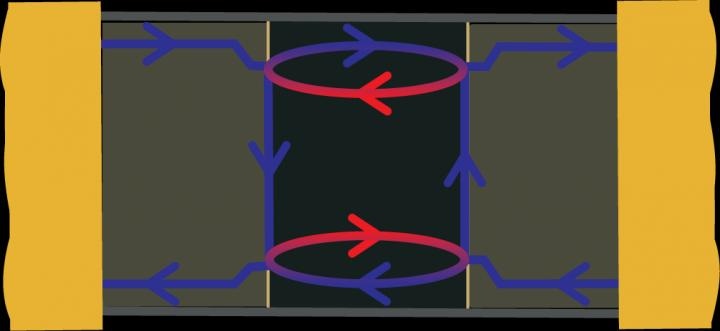Dec 4 2017
For decades, insulating materials were assumed to be "boring" materials, from an electronics point of view, since electrons are considered to be immobile and do not have the potential to contribute to electrical conduction.
A different class of insulators was has been recently proposed and experimentally found. They are called “topological insulators”, since it is possible to mathematically classify their electronic structure so that they are different than the typical, boring, "trivial" insulators.
 Schematic representation of the electronic behavior in the device described in the article. The arrows represent quantum channels where electrons propagate. Eectrons are allowed to change direction only at the central area, resulting under certain conditions in constructive interference. (CREDIT CIC nanoGUNE)
Schematic representation of the electronic behavior in the device described in the article. The arrows represent quantum channels where electrons propagate. Eectrons are allowed to change direction only at the central area, resulting under certain conditions in constructive interference. (CREDIT CIC nanoGUNE)
An interesting property of topological insulators refers to the fact that whilst they are insulating inside the bulk of the material, they are extremely good conductors at the edge of the material. At those edges, electrons pass in quantum channels in either direction, just like in a two- lane highway. Similar to that on a highway, U-turns are not allowed: it is not possible for the electrons on the edge to change direction without breaking the rules. This prohibition is lifted by the application of an external magnetic field, allowing electrons to turn.
The research, recently published and headed by Reyes Calvo, Ikerbasque Fellow at CIC nanoGUNE, and Fernando de Juan, presently at Rudolf Peierls Centre for Theoretical Physics, Oxford and joining the Donostia International Phisics Centre (DIPC) as Ikerbasque Fellow in 2018, presents a report on the interplay of quantum edge states all over a lateral junction in a HgTe quantum well, a canonical 2D topological insulator. From their findings, the researchers extract new information on the basic properties of topological edge states and they further suggest strategies in order to modify their interaction.
In our work, we test the consequences that allowing electrons to turn have in the conduction of our devices. We also show how under certain circumstances, electrons allowed to return seem to do it in an orderly manner, as if in some kind of round-about, generating a constructive interference.
Reyes Calvo, Ikerbasque Fellow at CIC nanoGUNE
This work offers fresh insight into the basic properties of the edge states and also on their conduction properties in 2D-topological insulators. These types of proposals to control the interactions and properties of these states are considered to be vital for their utilization in producing a new generation of electronic devices based on the quantum fundamental properties of materials.